Menu
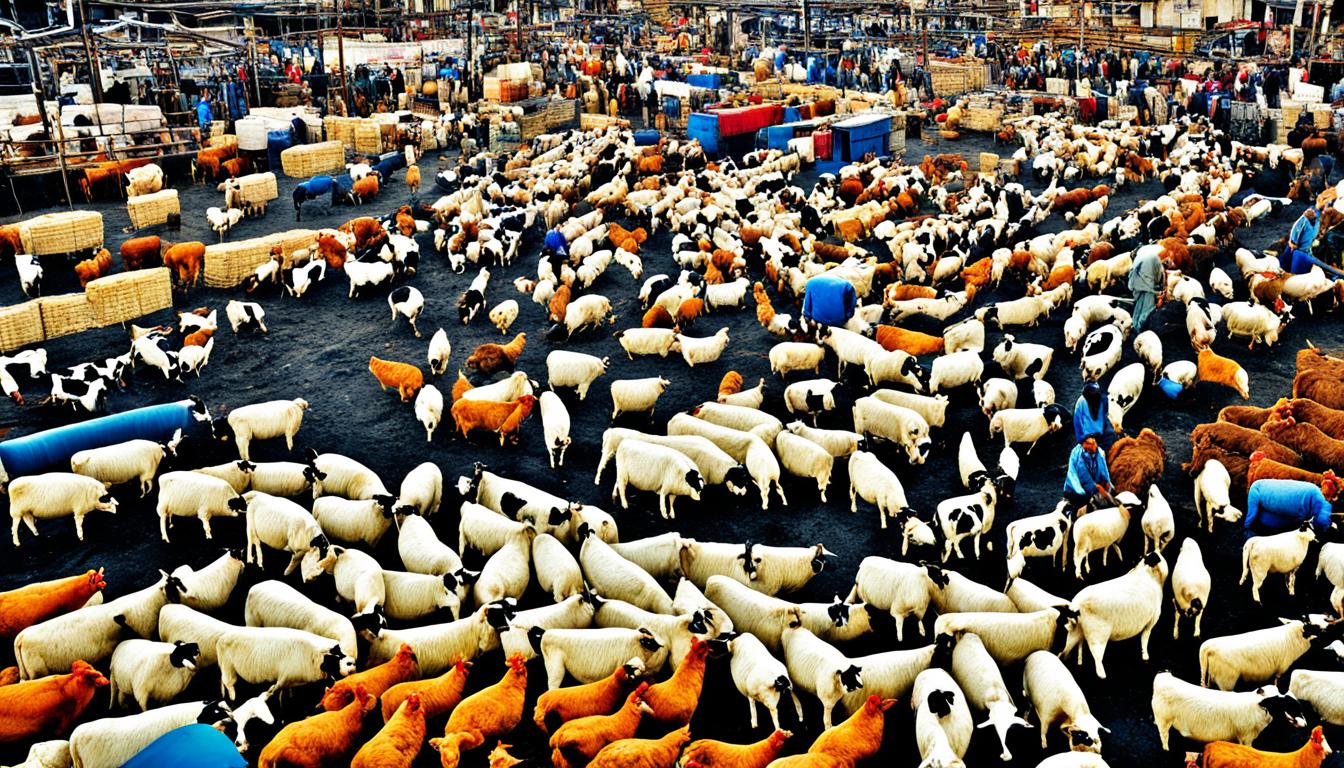
Did you know the global livestock monitoring market will leap from USD 5.6 billion in 2022 to USD 23.35 billion by 2032? This growth hits a high of 15.4% per year. It shows how profoundly technology is changing farming.
For those in agriculture, keeping up with livestock insights is key. The world’s growing population wants more meat and dairy. Using tech to improve farms isn’t just smart, it’s necessary.
IoT sensors are changing the game for looking after livestock and running farms better. With a market expected to hit USD 3775 million by 2032, up from USD 2565.5 million in 2021. This shows that using new tech is vital to make the best choices and keep up with demand.
Today’s global economy makes following livestock market trends very important. The animal health market was worth over USD 44 billion in 2021. It’s set to grow by 5% from 2022 to 2027. So, keeping up with market changes is key to success.
The livestock business needs careful study to see its full picture. Many things affect the market, like new farming methods and what consumers want. It’s vital for farmers to estimate costs accurately and early. This helps them make the best choices about what livestock to raise for profit.
It’s also smart to set different price goals. This gives flexibility when market conditions change. Meanwhile, keeping up with the latest market news is central to making good business choices.
Global events really shake up livestock markets. The Asia-Pacific region stands out for its fast-growing market. This is thanks to more pets and a higher demand for livestock products. Crises and tensions around the world can suddenly alter these markets. So, farming businesses must adapt quickly.
World economic changes, like currency values and trade rules, also play a big role. They affect how much people buy and the prices of livestock goods. It’s crucial for farmers to look at all options for selling their livestock. This includes different types of contracts and sales. By having a solid marketing plan, they can better understand and respond to these complex dynamics.
Here is a comparison of the key factors that influence livestock markets:
| Factor | Impact |
|---|---|
| Health Crises | Disrupts supply chains, affects livestock health |
| Geopolitical Tensions | Influences trade policies and market access |
| Economic Indicators | Fluctuating demand and prices due to GDP growth, inflation |
| Climate Change | Reduces crop productivity, influences feed costs |
Knowing about these factors is crucial for farmers looking to do well in the livestock market. The links between these events and their effects underline the need for farmers to stay well-informed. By doing so, they can keep their operations profitable and sustainable.
Technology in farming is changing how we farm. Precision livestock farming is at the heart of this change. It lets farmers use high-tech tools to keep a close eye on their animals. This helps them take better care of their livestock and improves farm productivity.
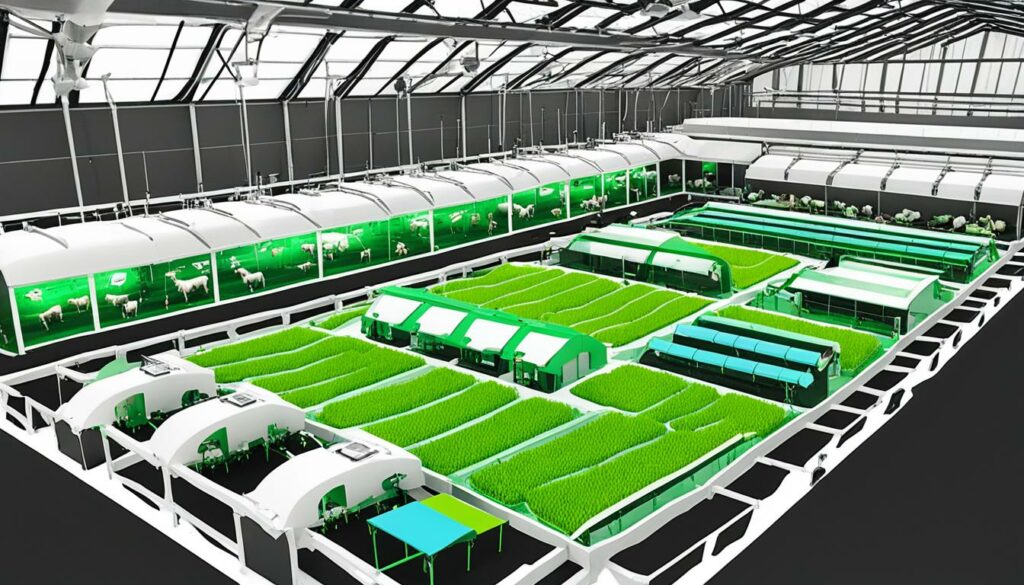
Precision livestock farming relies on advanced monitoring. It uses sensors connected through the Internet. This tech allows farmers to monitor their animals’ health, behaviour, and the environment in real-time. The insights gained help make better decisions for looking after the animals. However, the cost to adopt this tech can be a challenge for some farmers.
Technology also brings precision to feeding and milking the animals. This ensures they get just the right amount of food and are milked efficiently. It improves the quality of the farm’s products. With the world needing more meat, these advancements are vital. They make farms more efficient and treat animals better. This is why more investment in this tech is recommended.
There are still hurdles, like high costs and unsure future policies, to overcome. But, trusting the evidence and local advice can help with these challenges. The NFU, a farming group, backs better funding support and sharing important data. This will make it easier for farmers to use precision livestock farming.
The future of farming is bright, thanks to precision livestock practices. This sector is growing fast, showing how essential technology is for farming now.
The livestock farm equipment market is on the rise. By 2031, it’s expected to be worth over USD XX.X billion. That’s up from USD XX.X billion in 2023. The market is growing steadily every year.
Market Research Intellect expects big growth for farm equipment sales. New tech, regulations, and more informed customers are pushing this growth. The industry looks set for big things until 2031.
N. America, with the US and Canada, leads due to a strong economy and technology. Europe isn’t far behind, with its advanced infrastructure. It includes the UK, Germany, France, and Italy.
Asia-Pacific is speeding up, with China, Japan, India, and South Korea growing fast. It has a huge market thanks to a big population and more urban living. L. America also shows promise, with countries like Brazil seeing growth despite some challenges.
The Middle East and Africa, though behind, show potential for rapid growth. Countries like UAE, Saudi Arabia, South Africa, and Nigeria are getting ready for big changes, with a young population leading the way.
| Region | Key Factors | Growth Potential |
|---|---|---|
| North America | Technological Innovations, Robust Economy | High |
| Europe | Established Infrastructure, Consumer Preferences | Moderate |
| Asia-Pacific | Large Population, Urbanisation | High |
| Latin America | Economic Fluctuations, Political Instability | Variable |
| Middle East and Africa | Economic Diversification, Urbanisation | Promising |
The cattle market helps us see big economic trends in farming. Cattle prices change because of many reasons. These reasons help farmers plan and understand the livestock market.
Cattle prices change a lot and this is called being steady, firm, or weak. These changes are seen as higher or lower in reports. How many cattle people want to buy affects this too. This is shown as from very good to very light demand.
Supply reports are key, showing if there are many or few cattle for sale. The cattle’s quality and their health care also matter. If there aren’t many cattle being sold, we can’t be sure about the prices.
Knowing where most cattle were sold is important. It shows the usual price trends and the market’s mood. This helps farmers know the best times to buy or sell cattle.
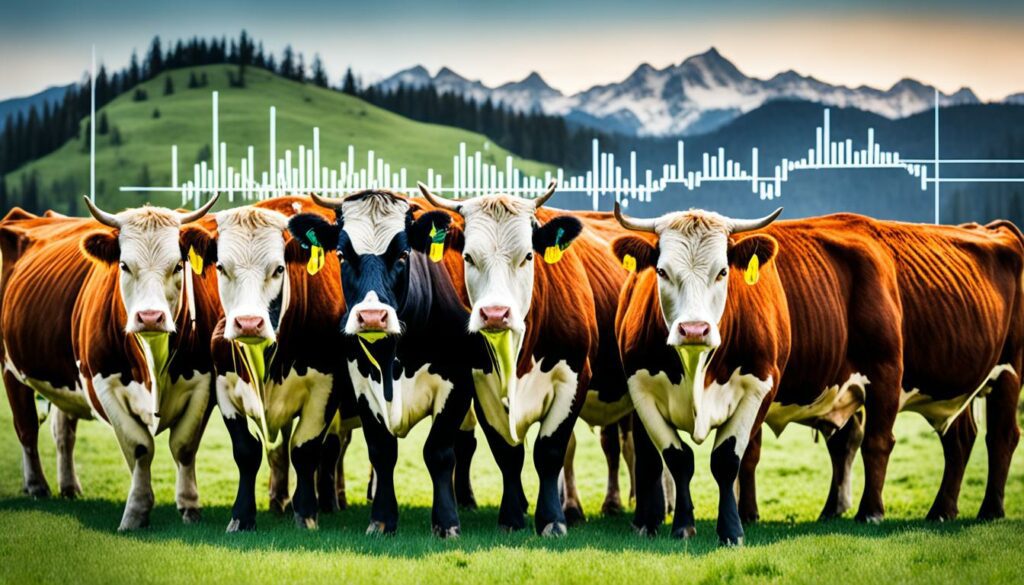
It’s important to know how cattle prices and the economy link. Interest rates can make cattle farming more expensive. This affects how much farmers might invest.
Farmers use financial statements to make smart choices. Knowing the income and costs helps run farms better. This is about making farming more strategic.
Knowing when prices are high or low helps farmers sell better. Planning with past price info can make farmers more money. Making smart choices, like how long to have the calving season, depends on what a farm wants to achieve.
Market News can give hints on where prices are going, especially in unsure times. This helps farmers make the right choice at the right moment. It’s all about staying up to date with the market.
| Factor | Impact on Cattle Prices |
|---|---|
| Feed Costs | Directly influence production costs and cattle prices |
| Climate Conditions | Affecting supply levels and cattle health |
| Global Demand | Shifts drive price levels based on market needs |
| Regulatory Changes | Imposing constraints or incentives that alter market dynamics |
Staying informed about the livestock market and the economy is key for farmers. It helps them adjust and make the most of good market times.
The market for livestock is always changing. There are many things that drive these changes and hold them back. It’s crucial for farmers and others in the industry to understand these. This helps them make good choices and take advantage of new chances in farming.
Many things help livestock farming grow. For instance, new technology like the Meats and Livestock Pro package gives detailed insights. It covers everything from beef and pork sales to how much inventory you have.
Yet, there are challenges too, like diseases and environmental issues. Using data from things like the USDA’s Cattle on Feed survey helps farmers. It guides them on handling these problems by knowing more about their cattle and pigs.
Even with challenges, there are lots of chances for farmers to boost their farms. The StoneX Meats and Livestock team offers vital data for smart decisions. Their insights on daily grains, livestock, and cotton are also very helpful.
By understanding the main drivers and finding creative ways to deal with challenges, farmers can really succeed. Staying ahead and making the right choices is key.
The sheep market has grown a lot in the last year, showing good signs for the future. Looking at sheep market data, we see changes in prices and production. These changes help us understand the market better.
In Newell, SD, Feeder Lamb Prices went up by 65.7%, rising from $164.57 to $273.00. San Angelo, TX saw a big increase in Light Weight Slaughter Lamb Prices, going up by 28.8% from $200.15 to $257.82. But, the price for live Slaughter Lambs went down by 3.0%. Even with this drop, they were 34.8% higher than the year before, showing how prices can change quickly.
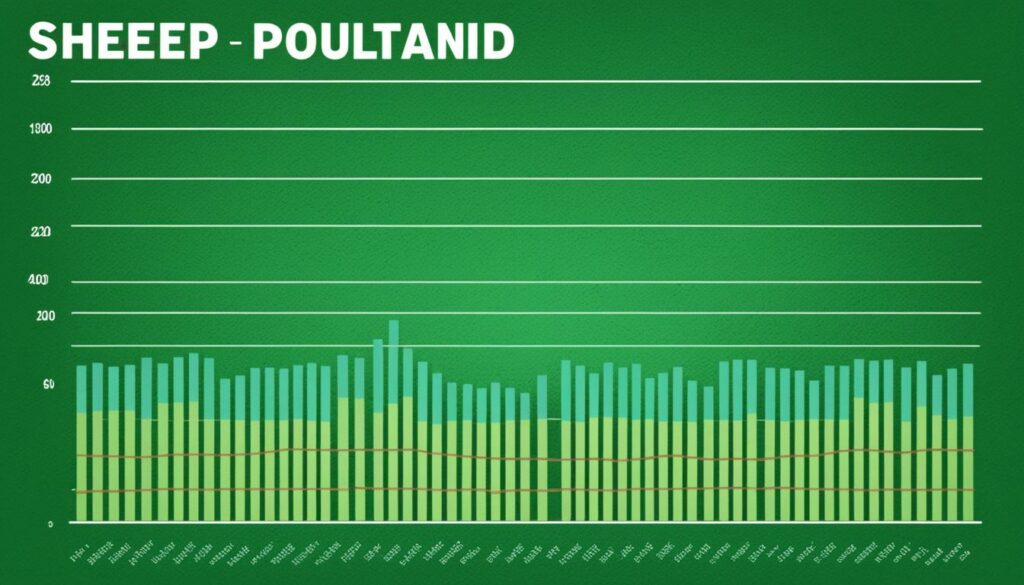
Ground Lamb prices went up by 1.1%, climbing from $647.18 to $656.78. On the other hand, the number of Federally Inspected Sheep & Lamb Slaughter decreased by 5.6% down to 34,000 sheep. FI Lamb & Mutton Production also dropped, from 2.2 million lbs to 2.1 million lbs, a 4.5% decrease.
Looking at future trends, the sheep market is set to grow a lot. By 2033, it’s expected to hit US$ 6.97 billion from the US$ 4.49 billion in 2023. This growth represents a strong future with a CAGR of 4.5%. The United States accounted for 28.0% of the market in 2022, worth US$ 1.20 billion.
The United Kingdom’s market is expected to grow from US$ 416.5 million in 2022 to US$ 667.4 million by 2033, at a CAGR of 4.8%. Germany and China held market shares of 18.1% and 8.3%, respectively, in 2022.
These projections are crucial for those in the sheep farming sector. The fluctuation of Australian wool prices highlights the need for constant livestock industry analysis. By staying up to date with agricultural market reports, along with knowing what consumers want and the latest farming tech, farmers can anticipate market changes.
The U.S. poultry industry plays a vital role in the livestock field. It’s the top chicken producer and the second biggest exporter. About 15% of all U.S. chicken meat is sent to other countries, showing its global importance.
Chicken is more popular than beef or pork in the U.S., showing how much people enjoy it. This means that those who raise chickens must always keep up with what people want and what the rules are.
By 2030, the world poultry market could be worth over USD 628,510 million. It’s growing solidly at about 7.50% each year. People in the developing world are eating more local meat, pushing up the demand.
Different types of poultry, like chicken, turkey, duck, are looked at against if they’re used at home or by businesses. Big names in the industry, such as Tyson Foods, JBS S.A., and Cargill, use the latest tools to make smart choices.
Chicken and turkey lost to bird flu highlight the need for better disease control. Also, how safe the food is in processing depends on the plant’s size and how it’s run. This influences how farms are run.
Farmers have to get better at looking after their animals and use more tech. With more people eating chicken around the world, farms must work smarter and greener. This is key.
| Key Statistics | Details |
|---|---|
| Global Market Value | USD 378,840 million (2023) |
| Projected Global Market Value | USD 628,510 million (2030) |
| CAGR | 7.50% (2023 to 2030) |
| U.S. Export Percentage | 15% (2022) |
| Main Exporter | U.S. (Second-largest) |
| Main Consumers | Developing and Emerging Markets |
The precision livestock farming market is heavily influenced by top companies like GEA Group and Afimilk. They, along with BouMatic, DeLaval, and Dairymaster, lead the way in new ideas and efficient solutions.
GEA Group and BouMatic are at the forefront of new milking technology development. These advancements are likely to dominate the market share in the coming years. The services these firms offer are also expected to grow fast, showing their importance in the industry.
Over the next five years, these services should grow in demand. This means their role in the market will become even more crucial.
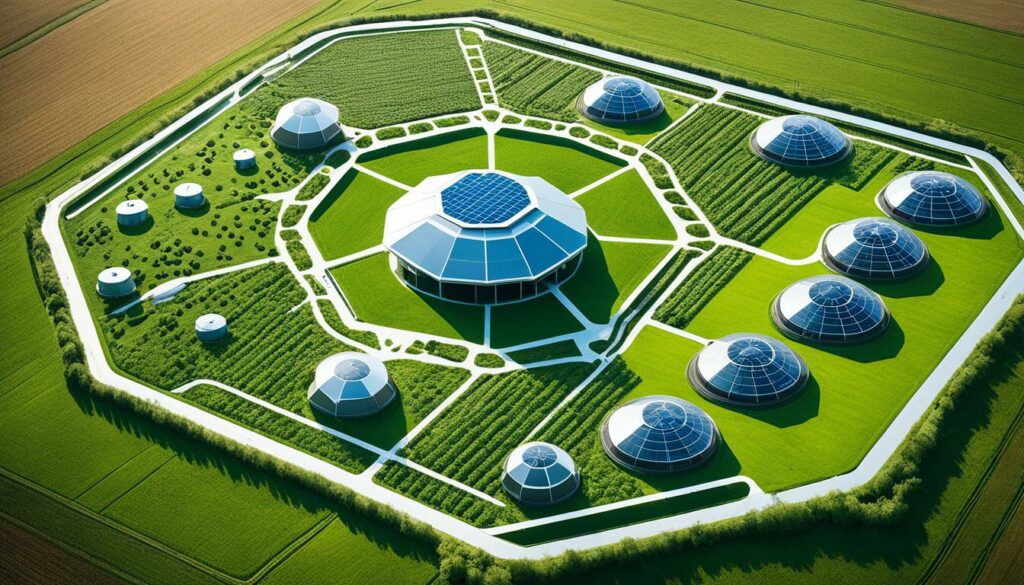
The field of precision livestock farming sees companies forging strong partnerships and making big investments in research. They are focused on reaching more customers worldwide. The market is set to grow from USD 2785 million in 2023 to USD 3775 million by 2032, marking a 5.2% increase yearly.
This expansion is driven by companies aiming to set new standards with their products. They target fast-growing regions like Asia Pacific and Europe, which will see the biggest jump in demand.
In the year 2023, big farms made up the biggest part of the market. This trend is predicted to continue. As such, these farms will remain the market leaders.
| Company | Key Innovations | Market Segment |
|---|---|---|
| GEA Group | Advanced Milking Robotics | Milking Systems |
| Afimilk | Precision Feeding Systems | Feeding Systems |
| BouMatic | IoT-Enabled Monitoring | Monitoring Systems |
| DeLaval | Automated Dairy Solutions | Dairy Farms |
| Dairymaster | Integrated Health Monitoring | Health Systems |
In summary, the cutting-edge work of key players is boosting the precision livestock farming sector. This growth creates a dynamic, competitive environment that spans the globe.
The impact of sustainability on farming is huge. There’s a big push to lower the farm’s impact on the planet. This includes adapting to what more people want. By 2050, we expect a 20% increase in the need for animal products like meat, eggs, and dairy. This makes using sustainable methods very important.
Livestock farming is changing to harm the environment less. It’s doing this while still producing the meat and other foods we need. It’s doing this in various ways, like combining trees and fields. This helps soak up a lot of CO2 and saves many plants and animals. A big project in Colombia turned a lot of land into these mixed areas. It trapped about 1.05 million tons of CO2 – helping the planet a lot.
In farming, some key green changes are happening. Methods to capture carbon, using energy better, and smarter ways to handle waste are gaining ground. For example, in Uruguay, dairy farms are managing their land and water better thanks to clever methods. The World Bank is putting most of its farm money into projects that help the climate. Over 61% of its spending on farms in the last three years went to such projects.
People are choosing foods in ways that help the planet more. This is making farmers rethink how they do things. They’re trying to cut their carbon footprints while caring more for their animals. The Global Conference on Sustainable Livestock Transformation discusses how this can be done. It promotes a way of farming that cares about the health of humans, animals, and the planet – all at the same time.
The livestock industry is one of the biggest sources of CO2 – about 7.1 GT every year. To survive and thrive in the changing market, farms need to be kinder to the planet. This is essential not just for business but for the health of the whole Earth.
| Region | Initiative | Impact |
|---|---|---|
| Mexico | Adopted sustainable energy technologies | Reduction of CO2 emissions by 3,388,670 tons in 2016 |
| Uruguay | Climate-smart livestock practices | Improvements in carbon sequestration, energy efficiency, and water conservation |
| Vietnam | Implementation of good animal husbandry practices | Benefited over 151,000 livestock farmers |
To sum up, using greener methods and knowing what people want are key. As consumers pick items that help the Earth more, farmers must keep up. They need to find new ways to farm that support both their businesses and the planet.
Farming is changing a lot because of IoT and smart tech. They make it easier to look after animals and use resources better. Now, farmers can use high-tech tools to make their work smarter and more efficient. More and more, in places like Asia Pacific, especially in India and China, farmers are turning to these smart ways of working.
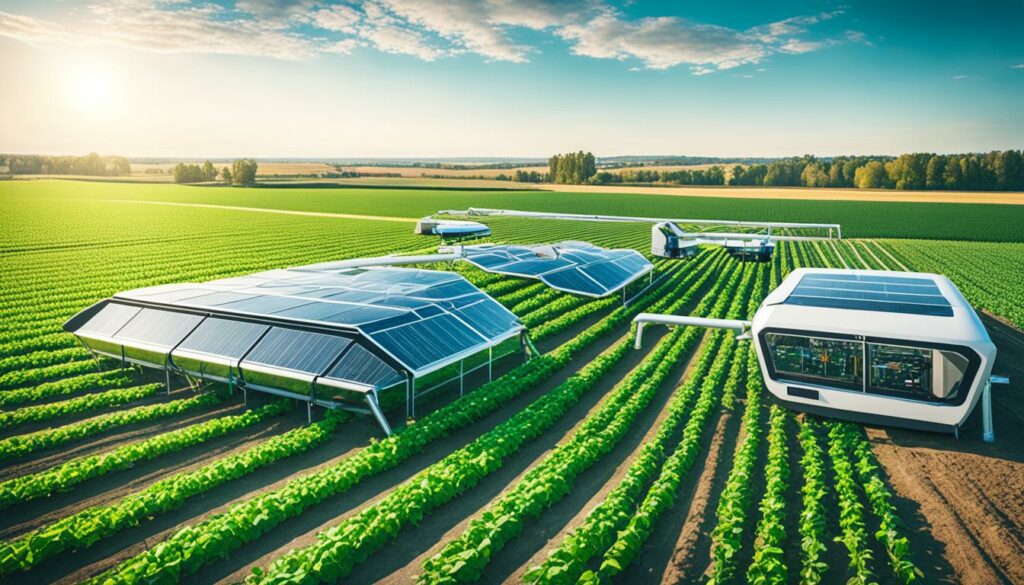
Remote sensing and GPS systems are key in modern farming. They check on things like how wet the soil is and where animals are, in real time. This helps in using resources wisely and acting quickly when needed. And drones are helping too, by taking super accurate pictures from the sky. This makes managing farms better and saving resources easier, showing the true value of smart farming.
IoT is making agriculture much better in using energy wisely. Systems for watering, controlling the climate, and feeding animals are getting smarter, cutting waste and saving money. In South India, for example, the CSIR is leading the way with IoT and drones to boost farm productivity. Projects like the one by LTIMindtree in Mumbai are helping too, by offering tech that improves crop quality without high costs. These efforts not only save farmers a lot of money but also help make farming more eco-friendly.
| Region | Market Size 2023 (USD Billion) | Projected Market Size 2032 (USD Billion) | CAGR (2024-2032)% |
|---|---|---|---|
| Global | 14.83 | 33.57 | 9.50 |
| Asia Pacific | Largest market | N/A | N/A |
In short, adopting IoT and smart tech is completely changing how we farm, for the better. These new tools are making farming more energy efficient, saving huge amounts of money, and improving how much we can grow. This is the future of farming.
In livestock trading, keeping an eye on changes is key for farmers. They need to be able to adapt quickly. These changes show us where the livestock market is heading, giving us clues for smart planning.
Cattle numbers are at an all-time low. Yet, beef production is high. Fewer cows are being turned into food, though, because they weigh more.
Feeder steer prices are up by $64 per hundredweight from last year. Despite more beef being sent overseas than usual, these exports are dropping now.
More pigs are around than there were last year. This means there’s more pork. Hog prices are good, with exports from the U.S. jumping up by 18 percent.
More chickens are being raised, too. The price of broilers at wholesale in the U.S. has gone up. But, the number sent abroad has fallen by over 10 percent.
In the dairy world, there’s less milk and fewer cows than before. Most dairy prices are down, but butter is getting pricier.
Farmers are looking for ways to protect their incomes from the wild market. One good method is to do a bit of everything. This spreads out the risk and keeps the money coming in.
Using new tech in farming can also help. Things like precision farming can make things more efficient and help the farm last longer. It’s also good to keep an eye on the laws and deals that affect farming. These can change the game fast.
Reading up on what’s happening in the farming world is always smart. Reports like the USDA’s can tell you what to expect. They’re great for making choices that will help your farm grow.
| Commodity | March 2023 | March 2024 |
|---|---|---|
| Feeder Steer Prices (per hundredweight) | $188.09 | $252.09 |
| Hog Prices (per hundredweight) | $45.24 | $55.24 |
| Composite Wholesale Broiler Price (cents per pound) | 124.52 | 129.52 |
| Pork Exports (February) | — | +18% |
Agricultural market reports are key for good strategic planning in farming. They give livestock market insights. This helps farmers keep up with conditions, trends, and forecasts. By looking at these insights, farmers can make smart choices. These choices can make their farms work better.
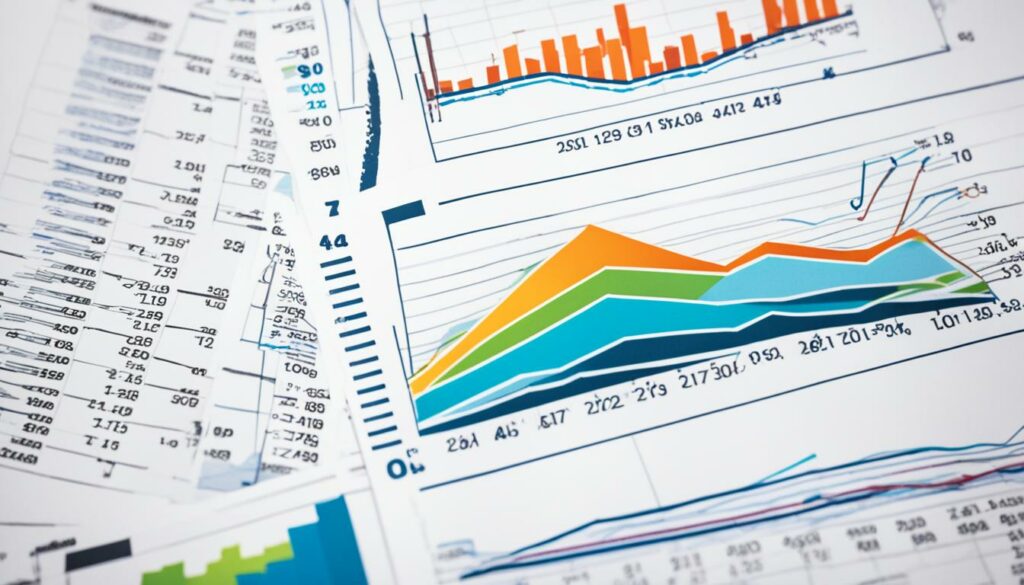
Knowing the value of agricultural market reports is big for farm management. Reports cover a range of areas including feed costs and prices. They also look at trends like exports. This makes it easier for farmers to guess what the market will do. For instance, various export shares shed light on the world’s interest in US meat products:
| Region | Pork Exports | Beef Exports |
|---|---|---|
| Russia | 4% | – |
| South Korea | 11% | – |
| Hong Kong | 7% | – |
| China | 15% | – |
| Japan | – | 22% |
With this information, farmers can see where the demand is high. They can then change what they grow to meet the demand. Also, by keeping an eye on how the market does, farmers can see what’s working. This helps them know what to improve.
Agricultural market reports play a big role in making smart decisions. They help farmers look at their own farms and what is and isn’t working. They also look at what others in the industry are doing. This makes sure farmers are ready for anything that could hurt their business. By using these reports, farmers can:
By using market reports well, farmers can also understand the costs of raising livestock. This includes detailed information from Kansas, showing:
| Metrics | Data |
|---|---|
| Monthly Kansas Fed Steer Marketing Weights | 1250 lbs |
| Monthly Kansas Steer Average Daily Gain | 3.5 lbs/day |
| Monthly Kansas Steer Death Loss | 1.2% |
| Long Term Kansas Steer Feeding Cost of Gain | $0.93/lb |
These details are key to helping farmers manage their farms better. Good strategic planning with the right market reports can improve decision-making. This can lead to big business growth.
In conclusion, the livestock industry is seeing big changes. It’s crucial for farmers to understand market trends and future directions. The U.S. cattle sector is changing, with 87.2 million cattle and calves counted in 2024, a 2% decrease.
This shift affects beef cattle and calf numbers too. Farmers must adjust to these supply changes. They need to make smart choices in this evolving market.
More cattle are on feedlots now, 2% up from last year. Yet, the average weight of dressed cattle hit a record high. By December 2023, this stood at 849 pounds. However, it is expected that fewer people will eat beef in 2024.
Even though beef exports were down in November, a bounce back is predicted. The U.S. Department of Agriculture expects a 1.3% increase in global beef exports for 2024. These trends show a dynamic market, ready for growth.
The change in the economy is also impacting farmers. Corn prices are falling, but interest expenses are up by 43%. This mix highlights the importance of being innovative. Modern farmers need to keep up with new technology and strategies. This way, they can not only cope but also excel in the changing agricultural world.
The livestock market is growing fast. This growth is due to smart farming and new technology. The industry is expected to grow by 15.4% each year from 2023 to 2032. This is thanks to smart IoT sensors that help manage livestock better.
Events like health crises and politics change the livestock markets. They cause prices to go up or down. To deal with this, people in the market need to change their strategies to keep their businesses strong.
Technology is key in running farms better today. We use monitoring systems, smart sensors, accurate feeding, and milking robots. These tools help keep an eye on and improve every part of the farm.
In 2021, the market for precision livestock farming was worth USD 2565.5 million. It’s expected to grow to USD 3775 million by 2032. We see a steady growth of 5.2% every year from 2024 to 2032. Knowing these numbers helps plan and get ready for the future.
Cattle prices change because of feed costs, the weather, how much people want, and rules. These things also decide how well the economy of farming does. Farmers have to make smart choices to run a better farm.
Using new technology, farming better for the Earth, and more people needing food are good signs. But sickness and the planet’s health are challenges. Farmers can do better by using these facts to become more productive and find new ways.
Sheep farming is an important part of agriculture. Looking at today’s facts and tomorrow’s guesses is vital for planning. We need to think about what people want and how farming is changing with new tech.
More people want to eat chicken and like quality products. This demand makes poultry farmers change the way they do things. They use new technology and look after health more to meet the changes.
The main people in this market are GEA Group, Afimilk, BouMatic, DeLaval, and Dairymaster. They’re always looking for new ideas and ways to do better.
Sustainable farming is important because people want food that’s good for the Earth. Farmers use methods that don’t harm the planet and look after their animals better.
Farms use smart tech like IoT and GPS to make things better. These tools check on the animals and the land in real time. This helps save energy and money.
Livestock trade changes because of what people like to eat, new tech, and the economy. Farmers need to keep up with news and make clever plans to do well.
Market reports tell farmers what’s happening, what might happen, and what choices to make. They’re key for finding chances and making smart long-term plans.